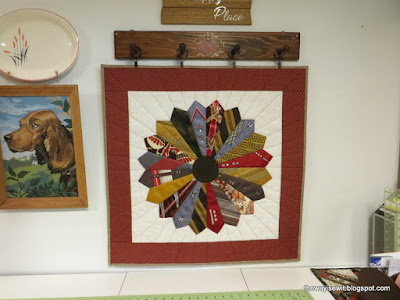I've been making some donation quilt tops during the past couple months. One with my own materials, and others from kits or orphan blocks sent my way by Jo at Jo's Country Junction to be put together and donated.
I've started to think of these as foster quilts: Something I have the temporary care and nurturing of along their journey to becoming a finished quilt and ultimately landing in the arms of someone in need of warmth and comfort.
First up, the one from me. When The Joyful Quilter put out a call for quilts (or parts thereof) for Lutheran World Relief, I promised to send something her way. I started pulling some older, half-forgotten things from the stash, a bit like going through and cleaning out the pantry. What hasn't moved in a while and needs to have another life? A little of this and a little of that, and pretty soon I had a nice subdued palette of florals and coordinating fabrics for a simple patchwork quilt.
Pictures don't really do this quilt justice. It had such a soft, cozy vibe. I also put together a backing and binding and sent everything off to The Joyful Quilter for quilting and donation to LWR.
Then I started on one of the projects that Jo had sent, which I presume was sent to her by one of her readers. Unfortunately, I don't know who that person was. If anyone reading this recognizes this, please let me know.
The blocks were already pieced. It just needed to be put together as a top. The maker had included extra 2.5-inch strips and other coordinating fabrics, so I used those to sash the top and make borders.
There was a yard or so of a rust colored solid fabric the maker sent along, and I had a similar rust colored print in my stash. Those pieces, along with some more of the 2.5-inch strips, were enough for a kind of improv backing. The remainder of the strips were just right for a scrappy binding.
 |
| (Backing) |
This turned out to be one very pretty quilt! It was a little large for me to quilt on my domestic machine, however, so I sent it on to Karen, a quilter I connected with through Jo's blog, to be quilted and donated.
Then I finished a Thimbleberries quilt kit that had been sent to Jo by "Connie in Wisconsin." Everything was there and complete to make this darling quilt top. It went together fast, and the fabric quality and instructions were excellent.
I remember when Thimbleberries quilts were quite the popular thing (this kit was dated 2002), but I had never made one until now. I can definitely see what the appeal was! I sent this top to Karen, along with the other one, for quilting and donation.
This last quilt top was a made with sampler orphan blocks sent by Jo. Again, unfortunately, the maker of these blocks is unknown to me. Please let me know if you recognize them as yours.
Once again, the blocks were already done. I just had to bring them all to a uniform size and sash them with a cafe au lait brown solid I had on hand. This one was also a good size, so I asked Joyful Quilter if she'd like to finish another one for Lutheran World Relief, and she said she'd be glad to.
It makes me so happy to see these quilts fostered to completion by various hands in the "quilt village." I'm happy to have played a small part in that!
And now for a technical thing. I'm trying something different with this post. Lately, my pictures seem to be blurrier in Blogger (and in my feed reader, Feedly), so I've increased the file size of the pictures uploaded for this post. Let me know if it causes any noticeable issues as far as page loading, etc.





















































